I Tested the Dyson Big Ball Turbinehead Canister Vacuum and Loved How It Instantly Cleans Hard Floors and Makes Light Work of Stubborn Pet Hair
Dyson's only canister vacuum is mostly a breeze to use, but struggles on thick carpets

The Dyson Big Ball Turbinhead – Dyson's only canister vacuum at the time of writing – boasts high-powered suction that can deliver strong cleans on most surfaces, but it struggles when cleaning thick carpets. It's great for pet hair and hard floors; however, if you like versatility and maneuverability when cleaning, this is an outstanding choice.
-
+
Strong suction
-
+
Versatile, easy to maneuver
-
+
Excellent performance on hard floors
-
+
Vacuums more fur from carpets than you can visibly see
-
+
Super-long cord reach
-
-
Floorhead can stop spinning on thick carpets
-
-
Some hairs get caught in the brushroll
-
-
Power and cord buttons don't feel durable
-
-
Can struggle with high volumes of debris
You can trust Homes & Gardens.
If you're hunting down the ideal new vacuum for your home, it's a smart idea to consider a canister vacuum. These versatile cleaners are super easy to use around the house, thanks to the motor being housed in a separate unit that you drag around.
And of course, it's smart to consider a Dyson. Even if the British brand mostly focuses on cordless vacuums now, I was excited to get my hands on their only canister vacuum, the Dyson Big Ball Turbinehead.
So, I tested it in a pet shelter, our dedicated test center, and in my own home to find out if it could be your new best vacuum cleaner.
The One-Minute Verdict
The Dyson Big Ball Turbinehead is a strong choice if you're looking for a versatile, easy-to-use vacuum cleaner that performs excellently on hard floors and can vacuum pet hair from thin carpets and upholstery.
It has some of the strongest performance on hard floors like linoleum and hardwood that we've tested, with a brushroll that instantly sucks away all manner of debris. It also performs well on low-pile carpets, but I wouldn't recommend it to anybody with thick carpets, as the brushroll will either slow down or completely stop spinning.
It's intuitive, easy to carry around the house, and maneuverable enough for effortless cleaning of tight spaces and furniture. But if you're looking for something with fewer quirks for a similar price, I'd recommend the cordless Dyson V11 or the corded Shark POWERDETECT Upright.
Dyson Big Ball Turbinehead: Specifications
Type | Canister |
Cord length | 21.7 feet |
Maximum reach (with hose and wand) | 35 feet |
Suction power | Up to 250 air watts |
Filter | Whole-machine HEPA |
Airflow (tested with anemometer) | 27.2 miles per hour |
Noise levels (tested with Decibel X app) | Up to 10.4 decibels |
Weight | 17.68 pounds |
Dyson Big Ball Turbinehead: Setup
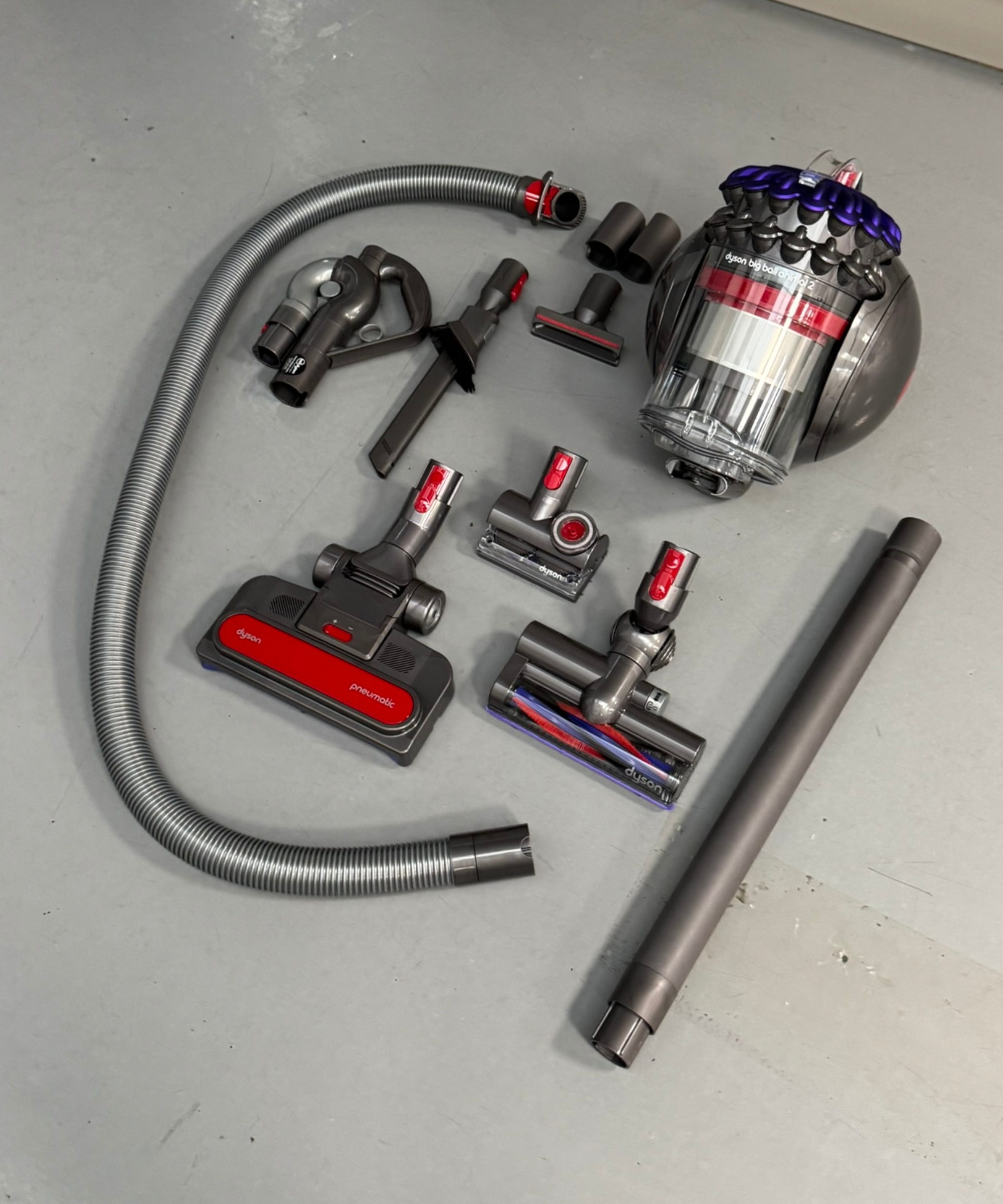
Setup takes fewer than 10 minutes once you understand the instructions.
When unboxing the vacuum, I was surprised by the amount of soft plastic packaging. Dyson is one of my favorite brands for shipping their products in sustainable packaging (cardboard and paper), so I wasn't expecting to see everything wrapped in plastic this time around.
Design expertise in your inbox – from inspiring decorating ideas and beautiful celebrity homes to practical gardening advice and shopping round-ups.
Setting it up involves connecting the floorhead, wand, handle, and hose to the vacuum, one by one. Different canister vacuums do this differently, so I looked to the instructions for guidance, only to find them – in my view – confusing and overwhelming.

The instructions were unclear, but luckily I've assembled canister vacuums in the past and had an idea of how to approach it.
Maybe others will find this more straightforward, but I had to rely on my experience testing canister vacuums. Luckily, once I got started, it all made sense. If you know what to do for each step, it shouldn't take more than 10 minutes until the vacuum is ready to use.
I tested the UK model of the Dyson Big Ball Turbinehead, the Dyson Big Ball Animal 2. It's the same vacuum unit as the US, just with a slightly different set of attachments and a gray and purple colorway (compared to the Turbinehead's yellow colorway).
The main floorhead is the same across both: The turbine head. It's similar to the Motorbar floorhead that we love in the Dyson V15 Detect and other top models, but a little smaller and without the same anti-tangle credentials.
But the UK version comes with an extra attachment that you won't find in the US model: The pneumatic head. I'd never seen a vacuum attachment like it and was excited to try it out – but if you're in the US, don't worry. The turbine head performed better in every way.
What Is the Dyson Big Ball Turbinehead Like to Use?

The turbine head features red and blue fins with bristles, designed to agitate carpets and pull out hair and dust.
The Dyson Big Ball Turbinehead is the only canister vacuum currently sold by Dyson. The brand now focuses mostly on cordless vacuums and floor cleaners (and they're some of the best in the world...), but the canister vacuum still has its USPs.
It comes down to versatility and maneuverability. As you're only holding the handle and not the entire vacuum unit, it's lightweight to carry, and it means you can get into tight spaces more effectively without maneuvering a big appliance.
But while the best cordless vacuums also share this benefit, they're limited by a battery, while canister vacuums can still house large motors that plug into the mains, leaving them unrestricted when it comes to suction power.
However, the Big Ball Turbinehead boasts 250 air watts of suction, which is the same as our best-on-test cordless vacuum, the Dyson V15 Detect, which costs more than twice as much.
The power and cord pullback buttons on the Turbinehead are on the canister 'ball, positioned so you can press them with your feet, although they seem a little delicate, and I wonder about their durability.
Others, such as the best Miele vacuums, have buttons that depress into the unit, while the Dyson Big Ball has the buttons sticking out, in a way that feels like the right amount of force could snap them off:
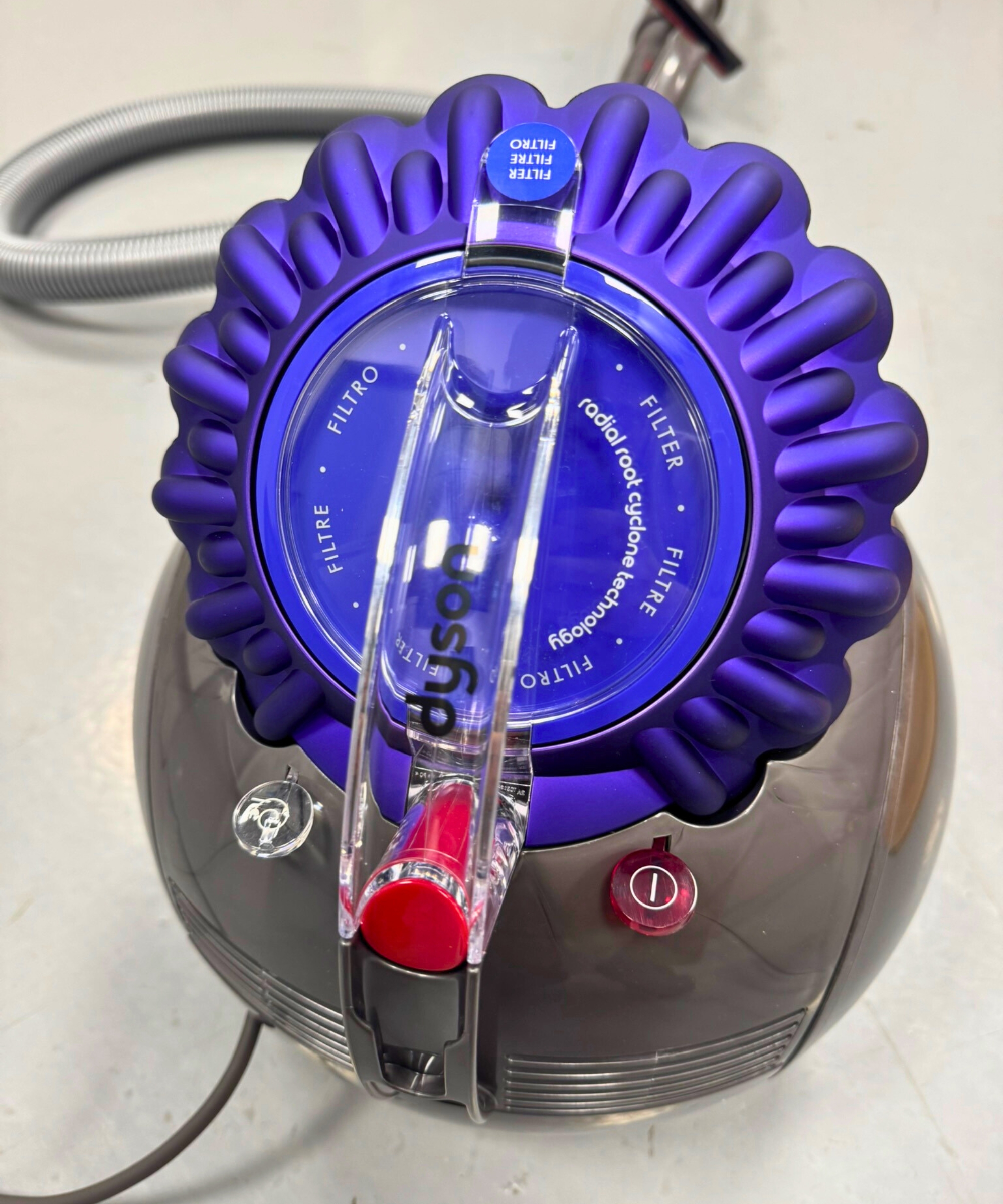
I worry about the durability of the delicate buttons attached to the vacuum using only thin plastic, as these are typically powered by your feet.
The power button also isn't the most responsive, so you have to press it firmly to make sure the vacuum turns on.
I tested the airflow using an anemometer, and it reached 27.2mph. That's higher than every cordless vacuum we've tested with the anemometer, demonstrating how much suction power a corded vacuum can pack.
I also tested the vacuum's noise levels using the Decibel X app, and it averaged 70.4 decibels. Vacuums range from around 60 to 80 decibels, depending on size and suction level, so the Big Ball Turbinehead sits comfortably in the middle.
A design note I love about the Big Ball Turbinehead is the fact that its 'ball' can never be toppled over. It was designed in a spherical shape to make maneuvering around corners easier, but this also allowed Dyson to design an anti-toppling mechanism:
There's also a suction release toggle on the handle. If you vacuum curtains, socks, or other un-vacuumable fabrics, you can quickly pull the toggle and air will flow out of the handle, releasing any suctioned objects.
And generally, like all of our favorite Dysons, it glides across the floor smoothly. I like that the wand extends, almost doubling in size to provide extra reach. My model also came with a wand clip that can store two attachments.
It'll certainly be safe when cleaning hardwood floors, and after testing the cord pullback four times in a row from different angles, I don't worry about it accidentally hitting your hand as it winds up.
Test 1: Flour and Sugar
In our dedicated test center, I tested the Dyson Big Ball Turbinehead using a half cup of flour and sugar on linoleum, wooden, and carpet flooring. These substances assess a vacuum's ability to pick up fine debris like dust and dead skin, while being clear visual tests, as we can see where residue is left behind.
On hard floors, everything was cleared in one forward pass, even between the wooden floor panels. That's super impressive – it's not often that a vacuum boasts such strong, neat performance.
On carpets, it took around 4-5 passes using the turbine head, and much longer using the UK-only pneumatic head.
At this stage of the testing, it seemed as if neither of the floorheads was designed for carpets. The pneumatic one doesn’t have any bristles to dig in, while the turbine head doesn’t have any grip adjustment, so it becomes quite hard to push forward, and the brushroll doesn’t spin as quickly. Strong suction is evident, though, as it gripped tightly to the surface.
The only adjustable setting is to stop the brushroll from spinning, which then makes the suction too hard to effectively move across the carpet. I'd look elsewhere for the best vacuums for carpets.
Test 2: Pantry
I also tested the Dyson Big Ball Turbinehead on linoleum, wood and carpet using a cup of cereal and green lentils. The lentils are slightly sticky and represent medium-sized debris, while the cereal poses a particular challenge for vacuum cleaners as it tends to be too large to fit into the floorhead. Some vacuums crush it down, some fling it around, and some vacuum it with no issues.
On linoleum and hardwood, the Dyson Big Ball Turbinehead crushed some cereal, but most was pushed forward and flung around. It struggled with a large amount of crumbs as it got caught in the small floorhead nozzle. Also, as the dustbin is on a tilt, some food got stuck in the side, and I had to shake it around to dislodge it.
Any sizable food pieces struggle to get sucked up in one attempt, and take a bit of back and forth or placing the floor head directly on top. But once I took the floorhead off, the suction was strong enough to pull up the large pieces from a 1-2 inch distance.
Now, it's normal for even the best vacuums for hard floors to get clogged with high volumes of food crumbs. The real test is in the vacuum's ability to deal with that mess afterwards, and whether the suction is strong enough to vacuum large pieces without the floorhead. The Big Ball Turbinehead passed this test.
On the carpet, it took a while. There were lots of flinging crumbs around, or getting caught in the floorhead and the wand. Neither the turbine nor pneumatic heads were able to properly pick up big pieces from the carpet.
Also, the inlet to the dustbin was clogged with food – not completely abnormal with a mess of this volume – but I expected better from a corded Dyson. Cordless models like the Dyson V11 performed much better, without these issues.
Test 3: Pet Hair
To see if the Dyson Big Ball Turbinehead could be one of the best vacuums for pet hair, I tested it in a local cat and dog shelter on hard floors, entrance mats, low-to-high-pile carpets, thick rugs, and upholstery.
The entrance mat is the toughest challenge for a vacuum with its bumpy, high-friction surface. The Big Ball Turbinehead did a really solid clean in about two passes, followed by a few strokes to get the rest of it. That's certainly better than average, but not as effective as what we've seen with other models like the Miele Blizzard CX1 Cat & Dog.
A few hairs remained, but that’s expected with this surface. And unlike the carpet tests above, the brushroll actually spun on this mat, likely because of the bumpy texture providing more breathing room.
The results were instant when vacuuming pet hair from hard floors. As soon as the floorhead neared any mess – whether pet hair, leaves, or dust – it pulled it in, sometimes from about half an inch away.
The long wand is great for reaching far from where you’re standing, providing more reach compared to other vacuums. The floorhead also vacuums right up to the edges without having to approach them at annoying angles.
On low-pile carpet, it was great, and again, the brushroll had no issues spinning at full speed. Everything was picked up instantly, and I could see great clumps of pet hair filling up the dustbin – more than I could see on the floor.
It grips low-pile carpet nicely, and the low profile of the floorhead lets it slide under furniture and doorstops. Its small shape also makes it easy to maneuver when cleaning stairs:
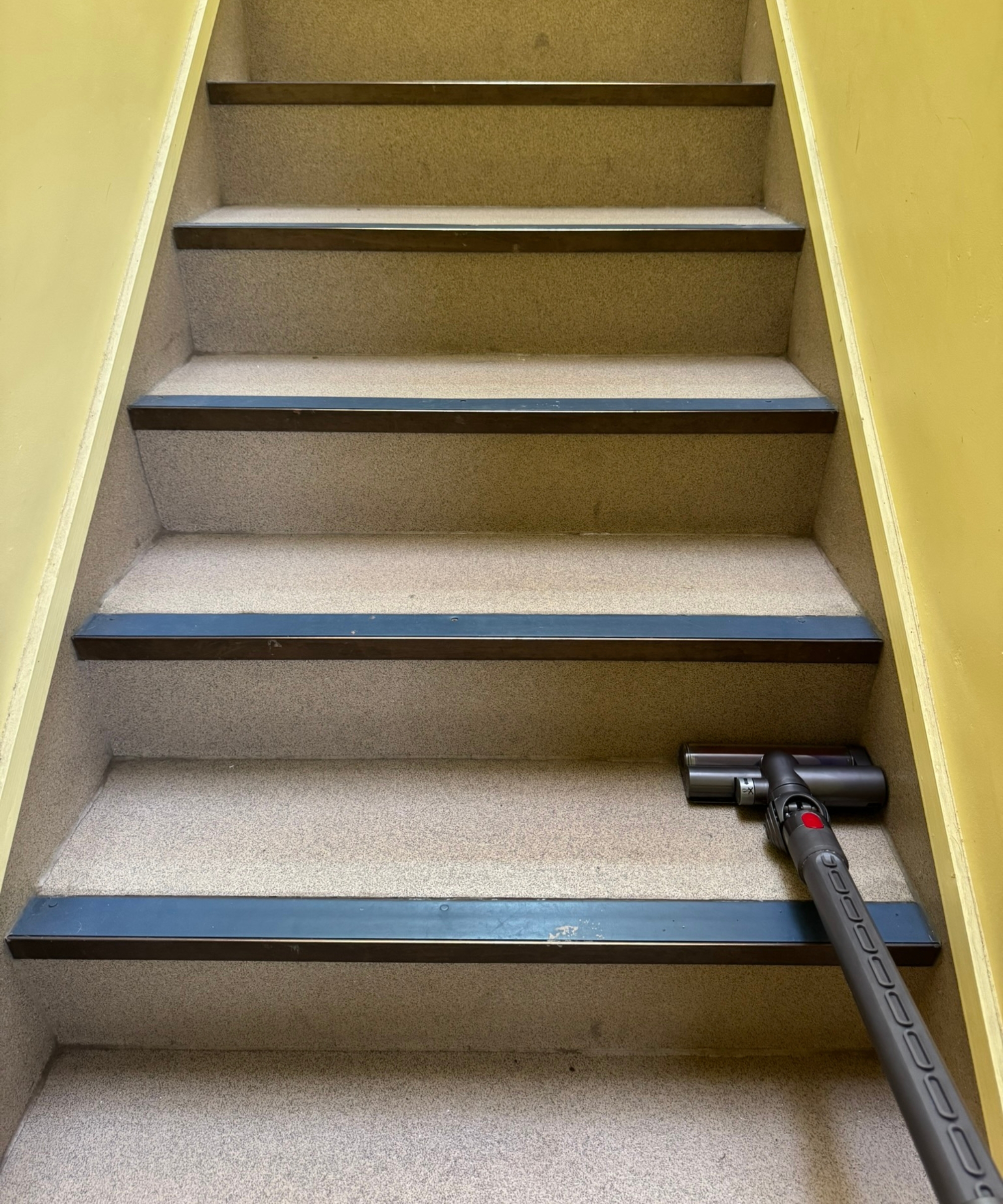
Stairs are easy to clean thanks to the vacuum's long reach and small floorhead.
While the brushroll had no issues spinning properly on the entrance mat and thin carpet, it stopped spinning on the pet shelter's thick rugs, just as it did at the test center.
When you move it forward, it starts spinning again, but you can feel that it’s not as fast, and it makes a noise as if it’s struggling. More debris was left over when vacuuming this surface than on hard floors and low-pile carpet. If your home has lots of carpets or thick rugs, I'd look elsewhere, such as the Shark POWERDETECT Upright.
After a few hours of vacuuming at the pet shelter, the dustbin was almost filled with fur, but there were a few wrapped hairs in the brushroll, showing that it isn't completely anti-tangle:
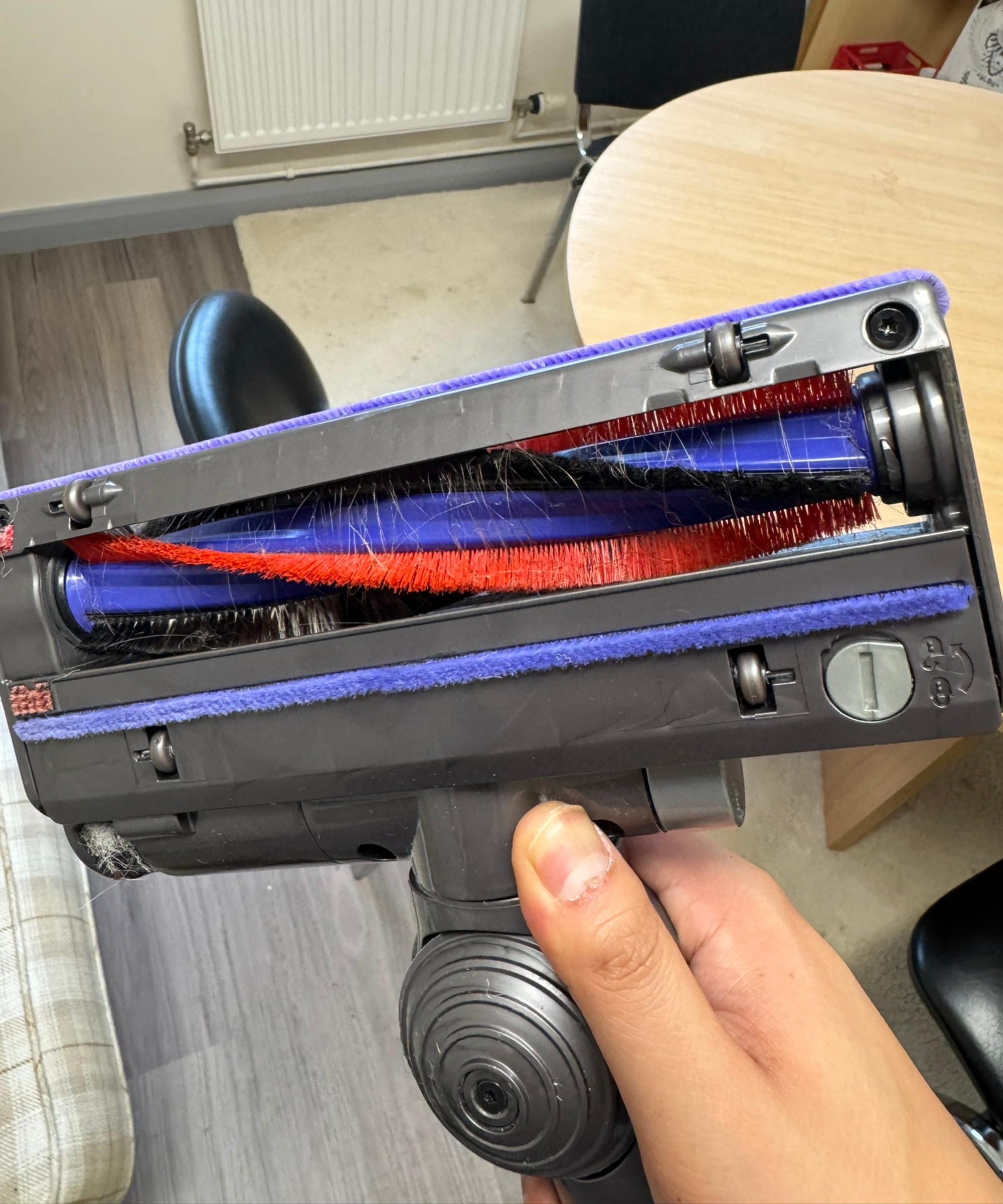
The turbine head isn't completely anti-tangle, and will likely need the caught-up hair cut out over time.
Test 4: Attachments
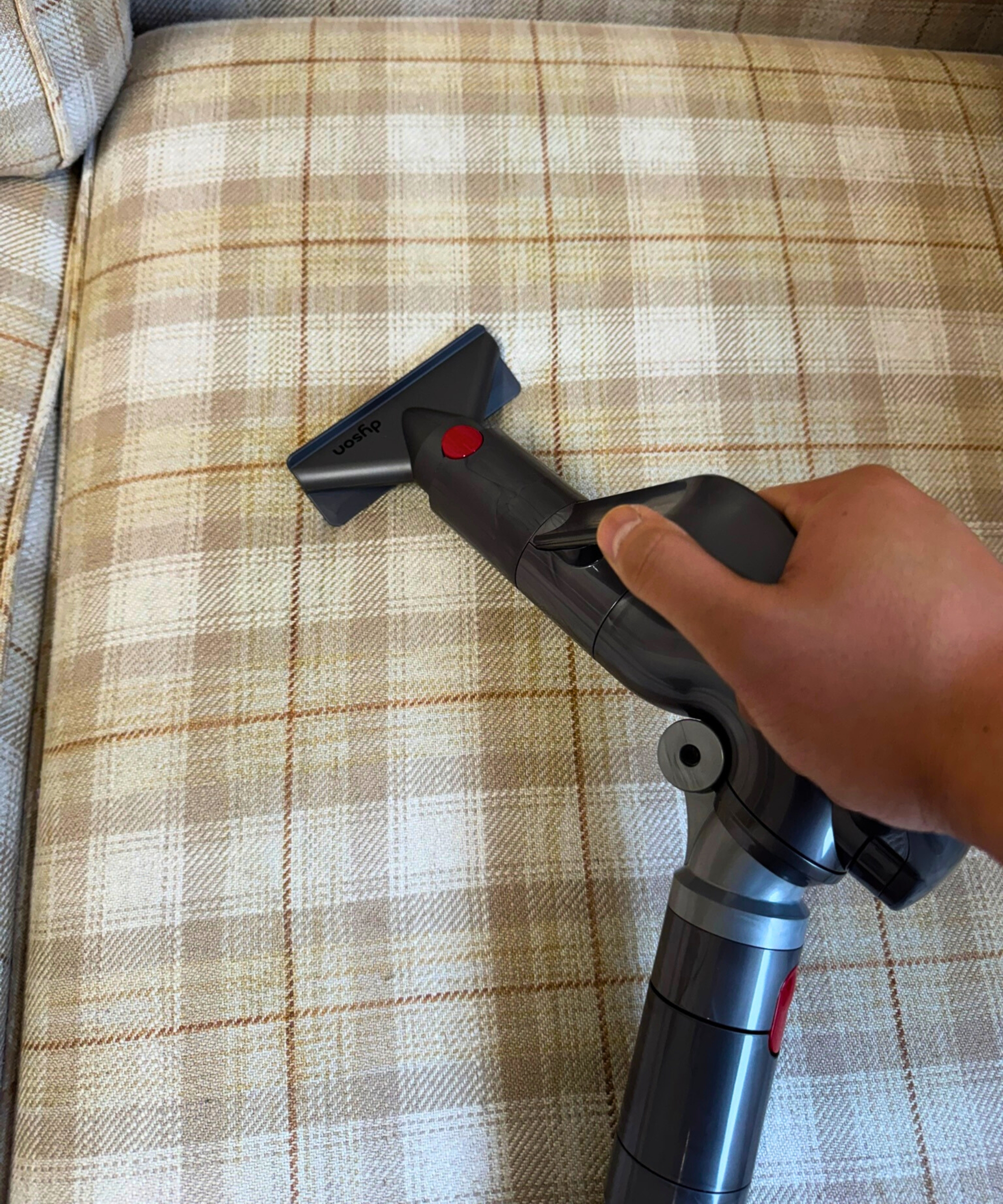
The upholstery tool was incredible at removing hair, dust and all kinds of dirt from fabrics.
The upholstery tool doesn't tend to be the strongest attachment for a vacuum cleaner, but the Big Ball Turbinehead's is incredible. It pulled all manner of dirt, dust, and pet hair from sofas and padded chairs, and would be a perfect tool for keeping your home clean with pets.
My UK model also came with a unique detangling hair attachment. I haven't seen this in any of the Dyson vacuums we've tested, which is surprising considering it's genuinely one of the best pet hair attachments I’ve used on padded upholstery.
Dyson Big Ball Turbinehead: Care and Maintenance

The dustbin is easy to empty with minimal dust blowback.
Many canister vacuums are bagged, using disposable vacuum bags that you dispose of once full. But Dyson is the brand that invented the bagless vacuum, so the Big Ball Turbinehead is one of the few canister vacuums that doesn't come with recurring bag costs.
It also has a lifetime washable HEPA filter that won't need replacing so long as you rinse it thoroughly with cold water every 1-2 months.
You detach the dustbin by pressing a button on the top of the canister. Then, hold it over the trash can and push the lever, and the dust will descend. It's quick and painless, with minimal blowback of dust and fine debris.
How Does the Dyson Big Ball Turbinehead Compare?
Costing $379.99 at Dyson (or £299.99 at Dyson UK), the Big Ball Turbinehead is reasonably priced. In fact, it's one of the cheapest vacuums that Dyson sells, with my personal favorite, the Dyson V15 Detect, costing $849.99 at full price.
Our best-on-test canister vacuums so far are the Miele Blizzard CX1 Cat & Dog [Amazon] and the Miele Complete C3 Cat & Dog [Amazon] – and they both cost around $1,000. They perform better in most aspects (except for being a little less maneuverable), but considering the steep price hike, I'd go for the Dyson over them.
But if you're looking at spending around $300-$400, I'd also recommend considering the Dyson V11 and the Shark POWERDETECT Upright. They both performed outstandingly on our tests, with high suction and easy usage, and can be found for around the same price. They also both work wonders on pet hair, without any hair wrap.
Next, look at the best Dyson alternatives for more affordable floorcare, and see our full deep-dive into how we test vacuums.

Dan is the Home Tech Editor for Homes & Gardens, covering all things cleaning, smart home, sound and air treatment across the Solved section. Having worked for Future PLC since July 2023, Dan was previously the Features Editor for Top Ten Reviews and looked after the wide variety of home and outdoor content across the site, but their writing about homes, gardens, tech and products started back in 2021 on brands like BBC Science Focus, YourHomeStyle and Gardens Illustrated.
They have spent more than 200 hours testing and reviewing vacuums for Homes & Gardens, and have even visited Dyson's engineering labs for the full low-down of the ins and outs of our trusty cleaners.
Dan has a BA in Philosophy and an MA in Magazine Journalism. Outside of work, you'll find them at gigs and art galleries, cycling somewhere scenic, or cooking up something good in the kitchen.
You must confirm your public display name before commenting
Please logout and then login again, you will then be prompted to enter your display name.
